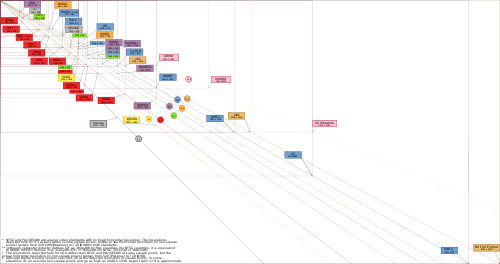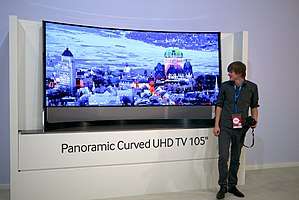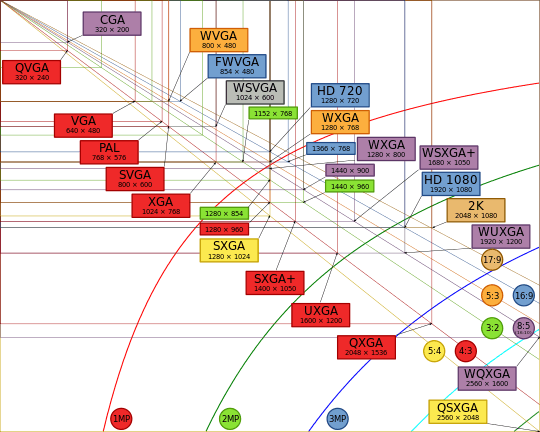5K resolution
5K resolution refers to display formats with a horizontal resolution of around 5,000 pixels. The most common 5K resolution is 5120 × 2880, which has an aspect ratio of 16∶9 with around 14.7 million pixels (just over seven times as many pixels as 1080p Full HD), with four times the linear resolution of 720p. This resolution is typically used in computer monitors to achieve a higher pixel density, and is not a standard format in digital television and digital cinematography, which feature 4K resolutions and 8K resolutions.[1]


In comparison to 4K UHD (3840 × 2160), the 16∶9 5K resolution of 5120 × 2880 offers 1280 extra columns and 720 extra lines of display area, an increase of 33.33% in each dimension. This additional display area can allow 4K content to be displayed at native resolution without filling the entire screen, which means that additional software such as video editing suite toolbars will be available without having to downscale the content previews.[2]
As of 2016, the world uses 1080p as the mainstream HD standard. However, there is a rapid increase in media content being released in 4K and even 5K resolution. Online streaming services such as Netflix and Amazon Video launched videos in 4K resolution in 2014[3] and are actively expanding their collection of videos in 4K resolution. As 4K content becomes more common, the usefulness of 5K displays in editing and content creation may lead to a higher demand in the future.
History

First camera with 5K video capture
On April 14, 2008, Red Digital Cinema Camera Company launched one of the first cameras capable of video capture at 5K resolutions. Red Epic uses the Mysterium X sensor which has a resolution of 5120 × 2700 and can capture at a framerate of up to 100 fps.[4] Cameras with 5K resolution are used occasionally for recording films in digital cinematography.
Some photographic still cameras such as DSLRs can exceed 5K resolution when capturing still images, but not when capturing video. For example, the Canon EOS 5D Mark IV announced in August 2016 has a maximum resolution of 6720 × 4480 pixels (around 30 megapixels in a 3∶2 aspect ratio) which is used for high resolution still images, but it can only capture video at a maximum of 4096 × 2160 and a framerate of 30 Hz.
First TV with 5K resolution
Samsung first demonstrated its 105-inch UN105S9W curved OLED TV at CES 2014. While Samsung lists the UN105S9W as a 4K UHD TV, it actually has native resolution of 5120 × 2160 (a 64∶27 or ≈21∶9 aspect ratio) which classifies it as a 5K display due to the horizontal pixel count of ≈5,000.[5]
First monitor with 5K resolution
On September 5, 2014, Dell unveiled the first monitor with a 5K resolution, the UltraSharp UP2715K. This monitor featured a 27-inch 5120 × 2880 display, giving it a pixel density of around 218 px/in.[6] The monitor only supported DisplayPort version 1.2, which is limited to 5120 × 2880 at 30 Hz. To work around this, the UP2715K implemented a system by which the bandwidth of two DisplayPort connections could be combined to achieve 60 Hz, using a picture-by-picture mode to virtually treat the display as two smaller 2560 × 2880 monitors side-by-side and driving each half with a separate DisplayPort connection.
Examples of 5K resolutions

| Resolution | Aspect ratio | Total pixels (Mpx) | Comments | |
|---|---|---|---|---|
| 5120 × 1440 | 3.5 | 32∶9 | 7.37 | Equivalent to two QHD (2560 × 1440) images side-by-side |
| 5120 × 2160 | 2.370 | 64∶27 (21+1/3∶9) | 11.06 | Equivalent to 4K UHD (3840 × 2160) extended in width by 33%; double the size of 2560 × 1080 in each dimension |
| 5120 × 2560 | 2.0 | 2∶1 (18∶9) | 13.11 | |
| 4800 × 2700 | 1.7 | 16∶9 | 12.96 | Five times the size of 960 × 540 in each dimension |
| 5120 × 2700 | 1.8962 | 256∶135 (≈17∶9) | 13.82 | Same aspect ratio as the DCI 2K (2048 × 1080) and DCI 4K (4096 × 2160) formats |
| 5120 × 2880 | 1.7 | 16∶9 | 14.75 | Double the size of QHD (2560 × 1440) in each dimension |
| 5120 × 3200 | 1.6 | 8∶5 (16∶10) | 16.38 | Double the size of 2560 × 1600 in each dimension |
| 5120 × 3840 | 1.3 | 4∶3 | 19.66 | Five times the size of 1024 × 768 in each dimension |
| 5120 × 4096 | 1.25 | 5∶4 | 20.97 | |
List of devices with 5K resolution
Monitors
| Aspect Ratio | Device | Size (in) | Dimensions (mm) | Dimensions (inches) | Resolution | Total pixels (Mpx) | Pixel Density (ppi) | Interface used for 5K | Comments |
|---|---|---|---|---|---|---|---|---|---|
| 16∶9 | Dell UltraSharp UP2715K[6] | 27 | 596.74 × 335.66 (684.67 diagonal) | 23.49 × 13.22 (26.95 diagonal) | 5120 × 2880 | 14.75 | 218 | Dual DisplayPort 1.2 | First 5K monitor released |
| Apple Retina 5K iMac[7] | Custom internal 8-lane DP 1.2 interface | First desktop with integrated 5K monitor released | |||||||
| HP Z27q[8] | Dual DisplayPort 1.2 | ||||||||
| Philips Brilliance 275P4VYKEB[9] | Dual DisplayPort 1.2 | ||||||||
| Planar IX2790 | DisplayPort 1.4 | ||||||||
| iiyama ProLite XB2779QQS | DisplayPort 1.4 | ||||||||
| LG UltraFine 5K Display[10] | Thunderbolt 3 | First 5K Thunderbolt 3 connected monitor released, aimed at Mac users, using a custom dual-DP 1.2 controller | |||||||
| 64∶27 (≈21∶9) | LG 34WK95U | 34 | 793.77 × 340.19 (863.6 diagonal) | 31.25 × 13.39 (33 diagonal) | 5120 × 2160 | 11.06 | 163 | Thunderbolt 3 / USB-C, DisplayPort 1.4 | First 5120 × 2160 monitor |
| Philips 349P9H | USB-C | ||||||||
| MSI Prestige PS341WU | USB-C, DisplayPort 1.4 | ||||||||
| 32∶9 | Philips Brilliance 499P9H | 49 | 1,198.08 × 336.96 (1,244.6 diagonal) | 47.17 × 13.27 (49 diagonal) | 5120 × 1440 | 7.37 | 109 | HDMI 2.0, DisplayPort 1.4, USB-C | First 5120 × 1440 monitor |
| Dell Ultrasharp U4919DW | DisplayPort 1.4, Thunderbolt 3 | ||||||||
| LG 49WL95 | HDMI 2.0, DisplayPort 1.4, USB-C | ||||||||
| Samsung CRG9 | DisplayPort 1.4 | ||||||||
Display interface and graphics card support
In order to fully utilize a display with a 5K resolution, the source and display both require support for advanced connection interfaces, since traditional interfaces such as VGA or DVI don't provide adequate bandwidth for 5K resolutions at acceptable framerates. The earliest interface to support 5120 × 2880 at 30 Hz or above was DisplayPort version 1.2, which supported the resolution at 30 Hz with 30 bit/px color depth. DisplayPort 1.2 was first implemented in the AMD Radeon HD 6850 and 6870 in October 2010.[13] NVIDIA introduced DisplayPort 1.2 on their products with the Kepler family of GPUs, starting with the GeForce GTX 680 in March 2012. The NVIDIA GeForce GTX 980, launched in late 2014, was the first graphics card to support HDMI 2.0 which also supports 5120 × 2880 at 30 Hz with 30 bit/px color depth. The NVIDIA GeForce GTX 1080 launched in mid 2016 and was the first graphics card to introduce support for DisplayPort 1.3 and 1.4,[14] which are capable of 5120 × 2880 at 60 Hz with 24 bit/px color depth. It was followed shortly by the AMD Radeon RX 480, which introduced support for HDMI 2.0 and DisplayPort 1.3/1.4 on the AMD side.[15]
Although 5K 60 Hz over a single cable was only made possible in 2016 with the launch of the GeForce 1000 series and Radeon RX 400 series, monitors which predate DisplayPort 1.3 such as the Dell UltraSharp UP2715K offer the ability to run at 5K 60 Hz by using two DisplayPort 1.2 connections concurrently in a specialized picture-by-picture mode.[16] The Apple Retina 5K iMac released in 2014 used a custom internal interface with 8 lanes of DisplayPort 1.2 (a standard DP connection is 4 lanes) to drive its display panel at 60 Hz.[17]
| Display mode | Maximum refresh frequency (Hz) | ||||||
|---|---|---|---|---|---|---|---|
| Resolution | Ratio | Color depth | HDMI 2.0 | HDMI 2.1 | DP 1.2 | DP 1.3–1.4 | DP 2.0 |
| 5120 × 2160 | (≈21∶9) | 8 bpc (24 bit/px) | 50 | 144 | 60 | 85 | 240 |
| 10 bpc (30 bit/px) | 30 | 100 | 30 | 60 | 200 | ||
| 5120 × 2880 | (16∶9) | 8 bpc (24 bit/px) | 30 | 100 | 30 | 60 | 200 |
| 10 bpc (30 bit/px) | 30 | 85 | 30 | 50 | 144 | ||
| Only the highest standard frequencies (24 / 30 / 50 / 60 / 75 / 85 / 100 / 120 / 144 / 200 / 240) are listed.
CVT-RB timing format and uncompressed RGB or YCBCR 4:4:4 color mode are assumed. | |||||||
See also
- 1080p Full HD – digital video format with a horizontal resolution of 1920×1080
- 1440p – digital video format with a horizontal resolution of 1440, aimed at non-television computer monitor usage
- 21:9 – a common widescreen cinema aspect ratio
- 4K resolution – digital video formats with a horizontal resolution of around 4000 pixels
- 8K resolution – digital video formats with a horizontal resolution of around 8000 pixels
- 10K resolution – digital video formats with a horizontal resolution of around 10,000 pixels, aimed at non-television computer monitor usage
- 16K resolution – experimental VR format
- Aspect ratio (image) – proportional relationship between an image's width and height
- Display resolution
References
- "Dell's new LCD monitor to be start of 5K resolution revolution?". September 18, 2014. Retrieved March 31, 2015.
- Smith, Matt (February 24, 2015). "Pixel Problems: Living with a 5K monitor isn't all it's cracked up to be (yet)". Digital Trends. Retrieved April 14, 2015.
- Waniata, Ryan (December 9, 2014). "Look out Netflix: Amazon rolls out free 4K UHD streaming". Digital Trends. Retrieved April 14, 2015.
- Covert, Adrian (April 14, 2008). "Red launches 5K Red Epic flagship camera". Gizmodo. Retrieved April 1, 2015.
- Wheatley, Mike (July 30, 2014). "Samsung & LG Begin Sales of 105" 21:9 4K, Nay, 5K TV". HDTVTest. Retrieved April 6, 2015.
- "Dell outs 'world's first' 5K display with a massive 5,120 × 2,880 resolution". Engadget. September 5, 2014. Retrieved April 1, 2015.
- "iMac with retina 5K display". Apple Inc. Retrieved April 5, 2015.
- "HP's new displays push curves, VR and a 5K priced so low you MUST read this story". PCworld. Retrieved April 5, 2015.
- "Philips Brilliance 275P4VYKEB has 5K Resolution PLS Panel". Guru3D. Retrieved September 9, 2015.
- "LG UltraFine 5K Display - Apple". Apple. December 31, 2016. Retrieved November 6, 2015.
- Matthew Humphries. "Forget 4K, LG ships a 105-inch 5K TV". PCMag Digital Group. Retrieved April 5, 2015.
- Anton Shilov. "Samsung prices its 105" 5K UHD curved TV: $120,000". KitGuru. Retrieved April 5, 2015.
- Smith, Ryan (October 21, 2010). "AMD's Radeon HD 6870 & 6850: Renewing Competition in the Mid-Range Market". Retrieved October 27, 2016.
- Smith, Ryan (May 7, 2016). "NVIDIA Announces the GeForce GTX 1000 Series: GTX 1080 and GTX 1070 Arrive In May & June". Retrieved October 27, 2016.
- Smith, Ryan (June 29, 2016). "The AMD Radeon RX 480 Preview: Polaris Makes Its Mainstream Mark". Retrieved October 27, 2016.
- "The world's first 5K monitor is here. You can stop going outside now. Forever". Digital Trends. January 29, 2015. Retrieved October 27, 2016.
- Smith, Ryan (October 16, 2014). "Hands On: Apple's iMac with Retina Display". Retrieved October 27, 2016.
